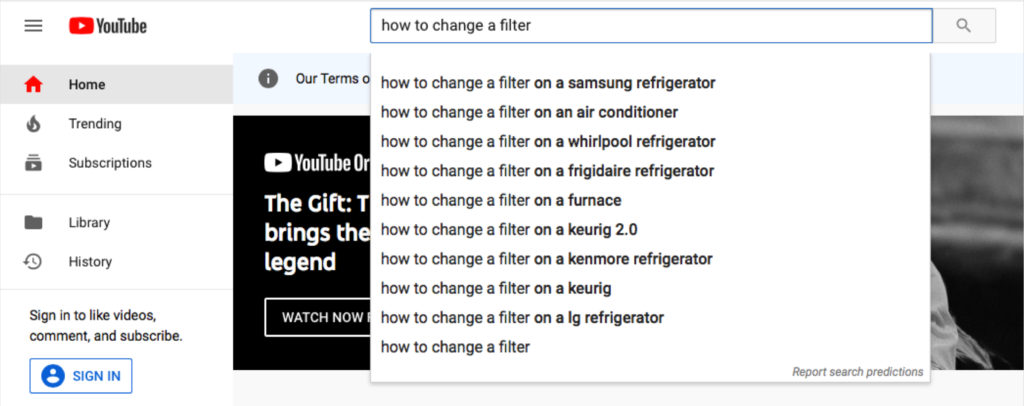Oh, hello there, friends! Welcome back to Simantel’s blog. We have some great content in store for you today, but first, a quick question:
Can you name all the major search engines?
There’s Google, obviously. There were 63,000 or so searches that happened on Google while you read that last sentence.
There’s Bing. People use Bing. No, really, people use Bing. Yahoo is still around. There’s also something called DuckDuckGo. If you have global markets to consider, you’re probably somewhat familiar with Baidu and Yandex – the respective search engines of China and Russia.
Did you name YouTube? I bet you did. Because you’re a brilliant and well-informed marketer, but I can guarantee you there are people in your organization who don’t consider YouTube anything beyond a video hosting platform. Crazy right?
YouTube is the second largest search engine in the world. It processes more than 3 billion searches a month. Which is why, when you’re thinking through your content strategy, video should be a part of the conversation.
It’s true, video did kill the radio star, and it continues to rapidly change the way we think about content.
When we talk about video marketing, it’s easy to jump to Super Bowl commercial style videos or funny shareable snippets for social. That’s because marketers primarily consider video a tool for driving early-stage awareness. But when 54% of consumers say they want to see more video content; we as marketers have a responsibility to deliver content across the entire customer journey.
I should start by saying that if you’re looking for tips on how to use video to drive early-stage awareness, this is not that article. But you can find that over in Disruptive Marketing: The Hook vs. The Strategy.
For the rest of this article, we’re going to stay focused on how to drive late-stage engagement with video.
STEP 1: DO YOUR RESEARCH
If you want customers to find your videos, you have to create content they are looking for. A smart marketer wouldn’t create written content without keyword research, so why invest in video without doing your homework to make sure it delivers on a customer inquiry?
You can do this in any tool you already use, or you can use the built-in search function of YouTube. All you have to do is type in topics and see what the predictive results for that topic include.

To maximize the likelihood of showing up in search results, both in platform and in Google’s search engine results page (SERP), consider framing your content in popular phrasing such as:
- How-to keywords (“How to rank on YouTube”)
- Reviews (“Dreamforce review”)
- Tutorials (“Video Ranking Tutorials”)
- Popular funny videos (“D6N Rap”)
To improve your video ranking, make sure you are including your keyword in the title of your video, at least three times in your description, and in the video tags. Oh, and within the actual video (the earlier the better).
PRO TIP: If you upload a video file to YouTube and do not change the title, the name of the file will automatically appear on the video – having little-to-zero impact on your SEO if the file name is something like “reel030486-small” because that’s how it needed to be catalogued internally.
STEP 2: DEVELOP & PUBLISH QUALITY CONTENT
There’s no amount of research or proper implementation of metadata that can make up for bad content! YouTube and their parent company Google will display videos that have high retention rates and strong engagement.
Some people may think that if there is not text available for a search engine to crawl, you lose your SEO impact. In reality, there are a few ways the platform can identify the quality of a video.
- Video Length – While there is no perfect length, the platform has been rewarding longer format videos. This is a change in the way most traditional marketers have approached video in the past. Short videos were thought to perform better, but as the appetite for video content has increased, so did the attention span of consumers. Now that customers are more willing to watch longer content, long videos rank just as well, if not better than, shorter videos.
- Comments – The more comments a video has, the higher it tends to rank. So, make sure the video you produce drives to a conversation. Encourage your audience to engage or continue the conversation. Also, put some time aside after you publish a video to make sure you’re responding to your comments to further encourage interaction.
- Shares and Likes – Shares and likes signal to YouTube and Google that your content provides value.
- Engaging Thumbnail – One of the worst things that can happen to an otherwise quality video is if your video ranks higher than others, but users scroll past it and select a lower ranking option. One easy way to discourage this behavior is to make sure, along with a good descriptive title, that there is an engaging thumbnail that stands out.
STEP 3: DISTRIBUTE AND DRIVE TRAFFIC
Once created, you want to drive engagement and consumption. Use your existing channels to promote your videos.
- Website – According to Forbes, the average user spends 88% more time on a website with video. And videos aren’t just keeping people around longer either, they’re driving more qualified leads. We see this very specifically with one of our manufacturing clients as well broadly across all of our work. If a site visitor spends ten minutes watching a video about your latest product, chances are they’re pretty interested.
- Social – When promoting video content on social, be sure to upload SRT files. Those are the mechanisms that enable captions. Captions are super important since 92% of users watch video with audio off. And can you blame them? No one wants to be “that person,” watching a video at full volume in public.
- Keeping Them Engaged – No matter where your audience is watching your video, you should remember to suggest other content for them as well. Whether through “related videos or content” at the end of a video or links in the copy, providing additional information encourages continued engagement. Don’t be pushy, but don’t be stingy with your content either.
The Convergence of B2B and B2C Marketing.
The thing to remember about all this, is that these tips are for everyone. Whether you’re a B2B company trying to engage your dealers, buyers or clients, or a company selling the newest, hottest shoes, video marketing is important. B2B and B2C marketing strategies are converging more and more every year. Business customers are still customers. They are still people who are more likely to want to watch a video than read a ten-page spec sheet and they still spend plenty of time on YouTube. Your business-based video content keeps your audience engaged with your brand, products or services.





